
Family facing 6th Grade math unit focusing on area and surface area.
- Subject:
- Geometry
- Mathematics
- Material Type:
- Unit of Study
- Provider:
- Illustrative Mathematics
- Date Added:
- 05/11/2020

Family facing 6th Grade math unit focusing on area and surface area.

In this unit, students learn to find areas of polygons by decomposing, rearranging, and composing shapes. They learn to understand and use the terms “base” and “height,” and find areas of parallelograms and triangles. Students approximate areas of non-polygonal regions by polygonal regions. They represent polyhedra with nets and find their surface areas.

Student facing 6th Grade math unit focusing on area and surface area.
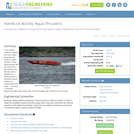
In this activity, students construct their own rocket-powered boat called an "aqua-thruster." These aqua-thrusters will be made from a film canister and will use carbon dioxide gas produced from a chemical reaction between an antacid tablet and water to propel it. Students observe the effect that surface area of this simulated solid rocket fuel has on thrust.

In this lesson, the students will discover the relationship between an object's mass and the amount of space it takes up (its volume). The students will also learn about the concepts of displacement and density.
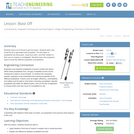
Rockets need a lot of thrust to get into space. In this lesson, students learn how rocket thrust is generated with propellant. The two types of propellants are discussed and relation to their use on rockets is investigated. Students learn why engineers need to know the different properties of propellants.
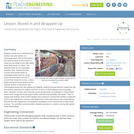
Students find the volume and surface area of a rectangular box (e.g., a cereal box), and then figure out how to convert that box into a new, cubical box having the same volume as the original. As they construct the new, cube-shaped box from the original box material, students discover that the cubical box has less surface area than the original, and thus, a cube is a more efficient way to package things. Students then consider why consumer goods generally aren't packaged in cube-shaped boxes, even though they would require less material to produce and ultimately, less waste to discard. To display their findings, each student designs and constructs a mobile that contains a duplicate of his or her original box, the new cube-shaped box of the same volume, the scraps that are left over from the original box, and pertinent calculations of the volumes and surface areas involved. The activities involved provide valuable experience in problem solving with spatial-visual relationships.
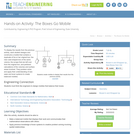
To display the results from the previous activity, each student designs and constructs a mobile that contains a duplicate of his or her original box, the new cube-shaped box of the same volume, the scraps that are left over from the original box, and pertinent calculations of the volumes and surface areas involved. They problem solve and apply their understanding of see-saws and lever systems to create balanced mobiles.
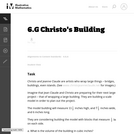
This task is primarily about volume and surface area, although it also gives students an early look at converting between measurements in scale models and the real objects they correspond to.
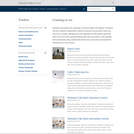
In these lessons students will explore the paintings of Horace Pippin and Wayne Thiebaud and the mobiles of Alexander Calder to discover and practice math and visual art concepts. Background and biographical information about the work of art and artist, guided looking with class discussion, and activities with worksheets using mathematical formulas and studio art provide the framework for each lesson.
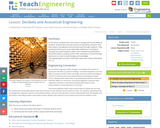
In this lesson, students learn that sound is energy and has the ability to do work. Students discover that sound is produced by a vibration and they observe soundwaves and how they travel through mediums. They understand that sound can be absorbed, reflected or transmitted. Through associated activities, videos and a PowerPoint presentation led by the teacher, students further their exploration of sound through discussions in order to build background knowledge.
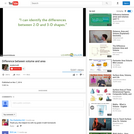
This video explains and shows definitions and example of the words: volume, area, surface area, and base. It also talks about word problems associated with volume and area. Students need to figure out if the provided story problems are finding the correct thing, volume or area, based on the object. Explanations of the correct answer are provided.

This math problem determines the areas of simple and complex planar figures using measurement of mass and proportional constructs. Materials are inexpensive or easily found (poster board, scissors, ruler, sharp pencil, right angle), but also requires use of an analytical balance (suggestions are provided for working with less precise weighing tools). This resource is from PUMAS - Practical Uses of Math and Science - a collection of brief examples created by scientists and engineers showing how math and science topics taught in K-12 classes have real world applications.
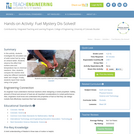
In this activity, students investigate the simulated use of solid rocket fuel by using an antacid tablet. Students observe the effect that surface area and temperature has on chemical reactions. Also, students compare the reaction time using two different reactants: water and vinegar. Finally, students report their results using a bar graph.
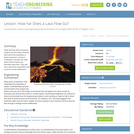
While learning about volcanoes, magma and lava flows, students learn about the properties of liquid movement, coming to understand viscosity and other factors that increase and decrease liquid flow. They also learn about lava composition and its risk to human settlements.
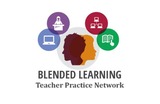
In this problem-based learning module, students will work collaboratively to improve the accessibility or safety of their school or community. For example, students could identify that accessibility ramps need to be added to the school property or additional sidewalks need to be created/repaired to increase the safety of students as they walk to school. Students would work together to create models of these improvements and create a communications plan that informs the stakeholders of the materials needed to create these improvements (i.e. using volume to determine the amount of concrete, using angles to determine measurements for ramps, etc..).
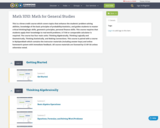
This is a three-credit course which covers topics that enhance the students’ problem solving abilities, knowledge of the basic principles of probability/statistics, and guides students to master critical thinking/logic skills, geometric principles, personal finance skills. This course requires that students apply their knowledge to real-world problems. A TI-84 or comparable calculator is required. The course has four main units: Thinking Algebraically, Thinking Logically and Geometrically, Thinking Statistically, and Making Connections. This course is paired with a course in MyOpenMath which contains the instructor materials (including answer keys) and online homework system with immediate feedback. All course materials are licensed by CC-BY-SA unless otherwise noted.
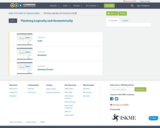

Topics List for this Lesson: Points, Lines, Planes, and AnglesTriangles Plus Similarity and ProportionsPerimeter, Area, and CircumferenceVolume and Surface Area

This sections has two activities, a 2D and 3D activity. Students will explore area in a real-life situation in the 2D project. They will also learn how to calculate a prospective budget proposal for a paint project, and how to write up a formal proposal email. Students will explore surface area and volume in the 3D project. They will be able to create a 3D object in TinkerCad and determine the amount of material needed to create that object.